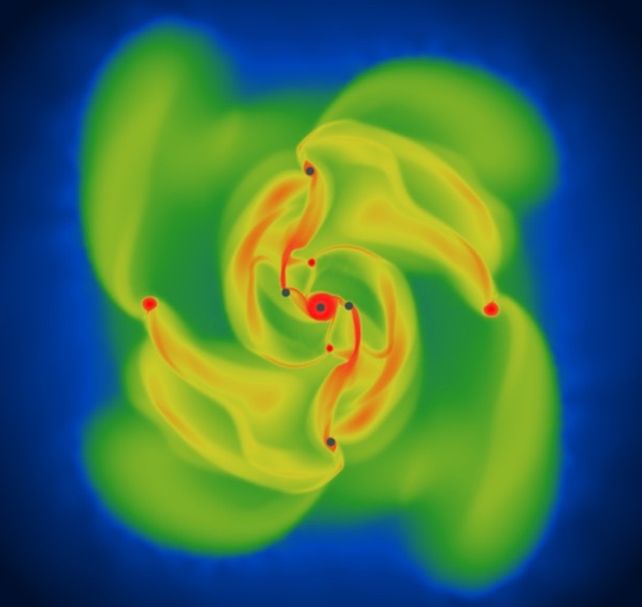ARTICLE AD
The formation of planets might not always go the way we picture it in our heads.
New simulations show large planets that form quite far away from their host stars start their lives not as a neat sphere, but more of a flattened disk like a fluffy pancake or an M&M — a shape called an oblate spheroid. As they spin, these protoplanets gradually draw in material, eventually settling into the more familiar round shape of Jupiter or a gobstopper. (Don't lie, you would eat a bowl of Jupiter.)
The finding arrived at by astrophysicists Adam Fenton and Dimitris Stamatellos of the University of Central Lancashire sheds some light on the myriad different ways to grow a planet, in the turbulent disk of dust and gas that roils around a baby star.
"We have been studying planet formation for a long time but never before had we thought to check the shape of the planets as they form in the simulations. We had always assumed that they were spherical," Stamatellos says.
"We were very surprised that they turned out to be oblate spheroids, pretty similar to smarties!"
Although we've found lots of planets out there in the Milky Way – over 5,500 confirmed to date – it's not entirely clear how they form. When a star is born, it forms from a clump in a huge, dense cloud of gas and dust in space; that clump collapses under gravity and starts spinning. Material around it forms a disk that spools into the baby star, feeding its growth.
That disk doesn't all wind up falling onto the star. What's left over forms the other things that make up a planetary system: the planets, the comets, the asteroids, the moons.
But how does the material in the disk come together? For smaller terrestrial planets like Earth, Venus, Mars, and Mercury, scientists think they are gradually built from the accretion of chunks of rock that stick together and accumulate until you end up with, well, a planet.
frameborder="0″ allow="accelerometer; autoplay; clipboard-write; encrypted-media; gyroscope; picture-in-picture; web-share" allowfullscreen>
For the larger gas giants, scientists believe something called disk instability might occur. This is when the rapidly cooling disk around the star breaks into chunks that condense under gravity and form into planets.
This is an attractive idea, because it can explain planets that are challenging to rationalize under accretion theory, such as planets that are far larger than expected for their star, planets on wide orbital separations, or large planets that form quickly.
Fenton wanted to better understand the process of disk instability planet formation, so he designed and ran complex simulations, tweaking different aspects of the process, such as the gas density, the temperature, and the velocity of the disk.
"It was an extremely demanding computational project requiring half a million CPU hours on the UK's DiRAC [Distributed Research using Advanced Computing] High Performance Computing Facility," Fenton says. "But the results were amazing and worth the effort!"
 Simulation of four protoplanets forming under disk instability around their star. The planets and star are marked with a black dot, with red representing higher density areas. (Fenton & Stamatellos, arXiv, 2024)
Simulation of four protoplanets forming under disk instability around their star. The planets and star are marked with a black dot, with red representing higher density areas. (Fenton & Stamatellos, arXiv, 2024)Those results revealed that gas giant protoplanets first form a flattened shape as they spin – which, given the centrifugal force involved, and the fact that the protoplanet is still a relatively loosey-goosey collection of matter at that stage, makes sense. Even the well-formed and much more compact planets of the Solar System have centrifugal bulges around their equators.
The simulation also suggests that material accumulates onto the growing protoplanet predominantly at the poles, rather than around the equator.
It's unclear what the finding means for the core accretion model, but the research does suggest that the properties of a protoplanet embedded in a stellar disk could appear to vary, depending on the viewing angle.
From the side, the pancake shape is more obvious, but from the top, it's easy to mistake the round shape for a sphere. We're getting better at spotting these developing planets, so it's important, the researchers say, to grasp how to interpret what we're looking at.
The research has been accepted into Astronomy & Astrophysics Letters, and is available on arXiv.

 1 year ago
92
1 year ago
92 

